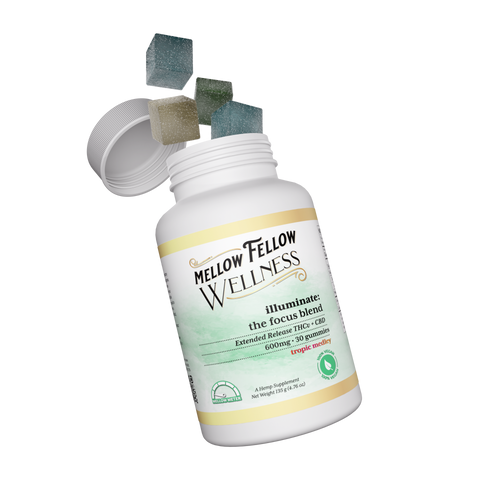How to Repair Cannabinoid Receptors

Cannabis has been a part of human’s pursuit of optimal well-being for generations, although understanding the how and why is the doing of modern science. Think of cannabinoid receptors as tiny sensors in your body that help keep things balanced. When they're not working right, it can throw off your well-being.
Luckily, fixing them isn't as hard as it sounds. Keep reading to learn more about the importance of cannabinoid receptors and how to repair them.
Key Takeaways
- Cannabinoid receptors are found throughout the body and influence homeostasis.
- CB1 receptors are mainly found in the central nervous system, and CB2 receptors are usually in peripheral tissues.
- The endocannabinoid system can influence functions like sleep, mood, cognition, pain, and inflammation.
- Maintaining healthy lifestyle choices can optimize cannabinoid receptor functionality.
What are Cannabinoid Receptors?
Cannabinoid receptors are specialized proteins that reside on the surface of our cells, integrating into the broader endocannabinoid system (ECS). Found in tissues throughout the body, they’re responsible for orchestrating balance in many bodily functions, from the rhythm of appetite and sleep to pain and mood modulation.
There are two main types of receptors: CB1 and CB2. CB1 receptors are mainly found in the central nervous system, affecting cognition, mood, and pain perception.
On the other hand, CB2 receptors are predominantly in peripheral tissues, supporting immune response and systemic balance.
Benefits of Stimulating Your Cannabinoid Receptors
Stimulating cannabinoid receptors can have an effect on many bodily functions, adding to the harmonious symphony of processes that can even culminate in health benefits.
Let’s explore some of the primary benefits of stimulating your cannabinoid receptors:
Pain Control
Activating CB1 receptors, primarily located in the brain and central nervous system, has a significant impact on mediating pain. This activation can lead to a decrease in the perception of pain, offering a natural form of pain relief.
This is particularly beneficial for individuals suffering from chronic pain conditions, as it may provide an alternative to pharmaceutical painkillers, which may have undesirable side effects.
Inflammation Reduction
When stimulated, CB2 receptors, found mainly in the peripheral tissues and cells of the immune system, may contribute to the reduction of chronic inflammation. Chronic inflammation is a root cause of many diseases, including heart disease, diabetes, and arthritis.
By potentially reducing inflammation, activating these receptors can promote a healthier immune response.
Mood Improvement
The endocannabinoid system's role in influencing neurotransmitter release can lead to mood improvements.
By stimulating cannabinoid receptors, there may be an increase in the release of mood-enhancing neurotransmitters, such as serotonin and dopamine, which may help alleviate symptoms related to stress and depression.
This mood regulation aspect is crucial for maintaining mental health and well-being.
Sleep Quality
The activation of cannabinoid receptors has been linked to regulating sleep cycles and promoting relaxation. This can lead to improvements in sleep quality, making it easier to fall asleep and stay asleep.
Good sleep is essential for cognitive function, emotional regulation, and overall health. By enhancing sleep quality, stimulating cannabinoid receptors can contribute to more restful nights and more productive days.
How to Repair Your Cannabinoid Receptors

There are quite a few things you can do in order to repair or enhance the functioning of cannabinoid receptors. From hitting the gym to taking a cold shower, here are some of the ways to optimize your receptors:
Daily and Regular Exercise
Doing some consistent physical energy is a cornerstone for health and for maintaning and enhancing cannabinoid receptors. Whether it’s the gym, a walk down the street, or a Pilates class, activities that elevate the heart rate foster an environment that influences the vitality of cannabinoid receptors.
Relaxing and Avoiding Stress
Stress disrupts our day-to-day lives so much, but did you know it also takes a toll on cannabinoid receptors? Relaxation techniques like yoga and meditation can help promote serenity, creating the perfect environment for cannabinoid receptors to recover and thrive.
Exposure to Cold Temperatures
Cold exposure is another great way to optimize cannabinoid receptor health. Whether taking a cold shower or embracing the power of cryotherapy, exposing the body to cold temperatures can stimulate endocannabinoid production, refreshing and awakening cannabinoid receptors.
Omega-3 Fatty Acids
Consuming food that contains Omega-3 fatty acids is essential for maintaining and repairing cannabinoid receptor health. They support the production of endocannabinoids, fostering resilience in the function of receptors. Find these fatty acids in fatty fish, nuts, and seeds.
Reducing Alcohol Consumption
While a drink probably won’t do much to impair the endocannabinoid system, excessive alcohol intake can dull the effectiveness of cannabinoid receptors. Monitoring alcohol consumption is a great way to preserve the functioning of these receptors and ensure their efficacy.
Sex Hormones
Hormones that play a role in our sexual health, like estrogen and testosterone, also play a pivotal role in cannabinoid receptor activity. Maintaining a balance of these hormones through healthy habits and lifestyle is key to a harmonious endocannabinoid system, supporting receptor function.
Drinking Coffee (in Moderation)
Nothing is good in excess, although the daily ritual of grabbing a cup of coffee just might be the secret to boosting endocannabinoid levels. Moderate coffee consumption optimizes the receptors, contributing to the well-being of the molecular conductors that bring balance to the body.
Daily and Useful Tips to Repair Cannabinoid Receptors
While it sounds complex, repairing these receptors can be done with a few tweaks to your daily routine. These can contribute significantly to the repair and maintenance of these receptors, enhancing the overall effectiveness of the endocannabinoid system.
Here are a few things you can you can do to repair your cannabinoid receptors:
Exercise Regularly
Regular physical activity, particularly cardiovascular or aerobic exercises, can significantly enhance endocannabinoid levels in the body. Exercise is known to boost not only physical health but also mental well-being, partly by influencing the endocannabinoid system.
Running, cycling, or swimming can lead to an "exercise high," attributed to increased endocannabinoid activity, improving mood, and reducing pain.
Meditation and Yoga
Meditation and yoga are powerful tools for managing stress and its detrimental effects on cannabinoid receptors. Chronic stress can lead to the downregulation of these receptors, diminishing their sensitivity and effectiveness.
Through practices like meditation and yoga, you can reduce stress levels, thereby potentially restoring the balance and function of cannabinoid receptors and enhancing overall well-being.
Try Cold Showers and Cryotherapy
Introducing cold exposure through cold showers or cryotherapy can stimulate the endocannabinoid system. This stimulation can lead to various health benefits, including reduced inflammation and improved mood.
The shock to the system from cold exposure is thought to trigger an adaptive response that includes enhanced cannabinoid receptor activity.
Add Omega-3 Fatty Acids to Your Diet
Incorporating Omega-3 fatty acids into your diet is essential for the health and repair of cannabinoid receptors. These fatty acids, found in foods like fish, flaxseeds, and walnuts, are vital components of cell membranes, including those of cannabinoid receptors.
Omega-3s can help improve the fluidity and functionality of these receptors, enhancing the effectiveness of the endocannabinoid system.
Moderate Your Alcohol Consumption
Alcohol can have a profound impact on the endocannabinoid system, with excessive intake leading to the impairment of cannabinoid receptor function. Keeping alcohol consumption in check is crucial for preserving the sharpness and responsiveness of these receptors.
Moderate drinking, or abstaining altogether, can help maintain the optimal functioning of the endocannabinoid system.
And What Decreases Cannabinoid Activity?
There are many things you can do to increase the functionality of the endocannabinoid system and cannabinoid receptors, but what about the don’ts?
Here are some things to avoid if you don’t want to negatively impact cannabinoid receptor function:
Excessive Cannabis Use
Frequent cannabis consumption can lead to tolerance, a state where cannabinoid receptors become less sensitive and more resistant to cannabis's effects.
This desensitization occurs because the body tries to maintain equilibrium in response to the constant activation of these receptors, reducing their responsiveness over time.
To counteract this, considering periods of abstinence or reducing the frequency of use can help restore receptor sensitivity, enhancing the effectiveness of cannabis when used.
Unhealthy Diet
Diets rich in sugary or fatty foods can negatively impact the endocannabinoid system. Such dietary patterns may disrupt the balance of this system, affecting its role in energy balance, mood regulation, and overall health.
Transitioning to a diet high in Omega-3 fatty acids—found in fish, nuts, and seeds—can support the endocannabinoid system.
Lack of Sleep
Quality sleep is foundational for the optimal functioning of cannabinoid receptors. Sleep deprivation can impair the activity of these receptors, affecting their ability to regulate mood, appetite, and cognition effectively.
Prioritizing sufficient and restorative sleep supports the endocannabinoid system's role in maintaining homeostasis and promotes overall health and well-being.
Chronic Stress
Long-term exposure to stress can have a detrimental effect on cannabinoid receptors, diminishing their functionality. This decrease can lead to imbalances in the endocannabinoid system, which is involved in stress response and emotional regulation.
Implementing stress-reduction techniques such as meditation, yoga, or deep-breathing exercises can help protect the integrity of cannabinoid receptors and maintain their proper function.
Being mindful of these potential pitfalls lets you navigate lifestyle choices according to what you want to get out of the endocannabinoid system. At the end of the day, it’s all about maintaining a balance of health and empowerment that allows you to make informed decisions.
If you’re curious about trying cannabinoid products and making the most of cannabinoid receptors, Mellow Fellow’s Wellness Line is a great place to start. One of the great things about Mellow Fellow is the empowerment of picking a product that works for you, your lifestyle, and your goals.

If you want to pop a little cannabis on the daily, try the Wellness Softgel Caps or the delicious Wellness Gummies. For a more hands-on approach, the Wellness Roll On Gel makes the case for topical relief. If neither of those is your thing, try your luck with a Wellness Tincture for day-to-day solace.
How to Repair Cannabinoid Receptors: Frequently Asked Questions
Why Do We Have Cannabinoid Receptors?
Cannabinoid receptors are found in the central nervous system and peripheral tissues. They work with the endocannabinoid system to ensure balance in the body, affecting functions like sleep, mood, cognition, pain, and inflammation.
Is it Possible to Not Have Cannabinoid Receptors?
While science is still out on whether or not it’s possible to have no cannabinoid receptors, CB1 receptors can be eliminated, blocked, or significantly reduced in number through factors like illness and lifestyle.
How Long for Cannabinoid Receptors to Return to Normal?
The recovery time of cannabinoid receptors varies from person to person, but the important part is consistent healthy practices and lifestyle changes.
Are There Cannabinoid Receptors in the Brain?
Yes, there are cannabinoid receptors in the brain; particularly CB1 receptors can be found in this region. CB2 receptors, on the other hand, can mostly be found in peripheral tissues.
How Many Cannabinoid Receptors are in the Human Body?
There are many cannabinoid receptors throughout the body, making it difficult to gauge exactly how many cannabinoid receptors are in the body. Following a healthy lifestyle and practicing good habits may make the number of cannabinoid receptors increase or optimize.Share on Social








Leave a comment